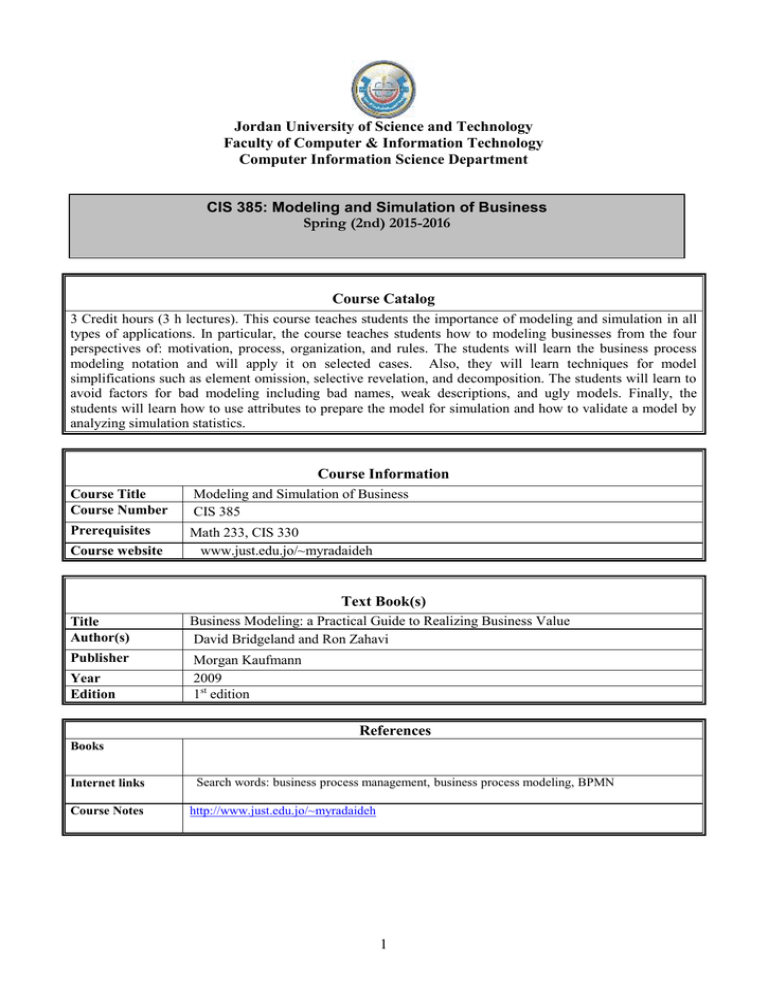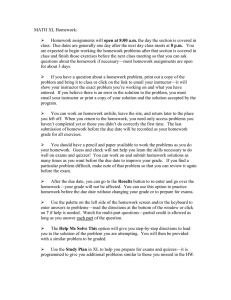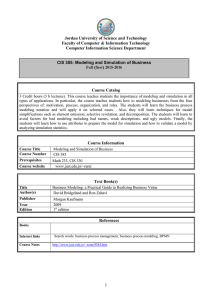Document 17731308
advertisement

Jordan University of Science and Technology Faculty of Computer & Information Technology Computer Information Science Department CIS 385: Modeling and Simulation of Business Spring (2nd) 2015-2016 Course Catalog 3 Credit hours (3 h lectures). This course teaches students the importance of modeling and simulation in all types of applications. In particular, the course teaches students how to modeling businesses from the four perspectives of: motivation, process, organization, and rules. The students will learn the business process modeling notation and will apply it on selected cases. Also, they will learn techniques for model simplifications such as element omission, selective revelation, and decomposition. The students will learn to avoid factors for bad modeling including bad names, weak descriptions, and ugly models. Finally, the students will learn how to use attributes to prepare the model for simulation and how to validate a model by analyzing simulation statistics. Course Information Course Title Course Number Modeling and Simulation of Business CIS 385 Prerequisites Math 233, CIS 330 www.just.edu.jo/~myradaideh Course website Text Book(s) Title Author(s) Business Modeling: a Practical Guide to Realizing Business Value David Bridgeland and Ron Zahavi Publisher Morgan Kaufmann 2009 1st edition Year Edition References Books Internet links Course Notes Search words: business process management, business process modeling, BPMN http://www.just.edu.jo/~myradaideh 1 Instructors Instructor Mustafa Radaideh Office Location Medical building, Ph1 level 0 Office Phone 720-1000 ext: 23501 E-mail myradaideh@just.edu.jo Class Schedule & Room Section Time Days Room Instructor 1 10:15 -11:15 Sunday, Tuesday, Thursday SF05 Mustafa Radaideh Office Hours Instructor Days Time Mustafa Radaideh Sunday, Tuesday Monday, Wed 3:15-3:45 1:00-2:00 Teaching Assistant(s) Instructor Assistant Mustafa Radaideh Jafar Badarneh Topics Covered The schedule is subject to change depending upon the actual class dynamics and workflow during the semester Topics Chepters in Text Week number Why Business Modeling Modeling Fundamentals Business Process models Creating a Good Model Business Model Analysis Business Simulation Ch 1 Ch 2 Ch 5 Ch 7 Ch 10 Ch 11 1, 2 3, 4, 5 6, 7, 8 9, 10 12 13, 14, 15 Course Objectives No. 1 2 3 4 Object Realize the importance of modeling and simulation in all of their applications; especially in business Learn about the four disciplines for business modeling Learn and practice business process modeling Learn to prepare a business model for simulation 2 Mapping Course Outcome Mapping Program Outcome Assessment Methods 1, 2 1, 7, 10 Quizzes, Exams, project 3, 4, 5 1, 3, 7, 9, 10 6, 7, 8, 9, 10 2, 3, 4, 5, 6, 11 11, 12, 13, 14 2, 3, 4, 5, 6, 11 Quizzes, Exams, project Quizzes, Exams, project Quizzes, Exams, project Course Outcomes No. Related Chapters Outcome 1 Be able to explain the importance of modeling and simulation 2 Be able to describe the driving forces behind business modeling 3 Be able to discuss the four disciplines of business modeling 4 Be able to discuss the concepts of fidelity, usefulness, complexity, and attractiveness 5 Be able to discuss the concept of traceability 6 Be able to identify the elements of business process modeling notation (BPMN) 7 Be able to design business process models using BPMN 8 Be able to reengineer business processes 9 Be able to discuss factors behind bad modeling 10 Be able to explain the concept of model verification 11 Be able to discuss the different analysis techniques 12 Be able to prepare a model for simulation 13 Be able to suggest testing scenarios for a simulated model 14 Be able to interpret and discuss simulation results Ch1 and slides Ch1 and slides Ch1 and slides Ch2 and slides Ch2 and slides Ch5 and slides Ch5 and slides Ch5 and slides Ch7 and slides Ch7 and slides Ch10 and slides Ch11 and slides Ch11 and slides Ch11 and slides Program Outcomes No. 1 2 3 4 5 6 7 8 9 10 11 Outcome An appropriate mastery of the knowledge, techniques, skills, and modern tools of their disciplines An ability to apply current knowledge and adapt to emerging applications of mathematics, science, engineering, and technology An ability to critically analyze a business problem within its unique context An ability to design regular or innovative IT-based solutions An ability to identify, analyze and solve technical problems An ability to function effectively and efficiently on teams of different specialties A recognition of the need for, and an ability to engage in lifelong learning An ability to understand professional, ethical and social responsibilities A respect for diversity and a knowledge of contemporary professional, societal and global issues A commitment to quality, timeliness, and continuous improvement An ability to participate and/or supervise the implementation of IT-based solutions 3 Evaluation Assessment Tool Quizzes Project First Exam Second Exam Final Exam Expected Due Date Upon notification Upon notification According to the department schedule According to the department schedule According to the University final examination schedule Weight 5% 10% 25 % 20 % 40 % Policy Attendance Quizes Exams Attendance is very important for the course. In accordance with university policy, students missing more than 10% of total classes are subject to dismissal. Penalties may be assessed without regard to the student's performance. Attendance will be recorded at the beginning or end of each class. Students are expected to keep up with the material as it is presented and be ready to take a quiz when requested. All exams will be CLOSE-BOOK. The date of exams will be announced ahead of time. Prepared by: Mr.Mustafa Radaideh Last Modified: Feb 5, 2016 4




